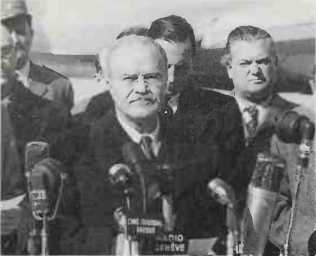Molotov, Vyacheslav (18901986). Russian. Major role in the Bolshevik Revolution; joined Politburo; Soviet PM, 1930—41. A close associate of Stalin; appointed Foreign Minister in May 1939 and remained in office throughout World War II and into Cold War.

Molotov, Vyacheslav (18901986).
Molotov Cocktail (Breadbasket). This name for an improvised hand grenade - typically a petrol-filled bottle with a rag wick - dates from its use against the Red Army during the invasion of Finland, 1940, when the incendiary-bomb clusters dropped by the Soviet Air Force were called “Molotov Breadbaskets”, after the Soviet Commissar for Foreign Affairs.
Moltke, Gen Helmuth Graf von
(1848—1916). Ger. Nephew of the Prussian hero of 1866 and 1870, Moltke succeeded von Schlieffen as Chief of the German General Staff in 1906. He advocated an early war against the Entente powers but significantly altered Schlief-fen’s war plan by strengthening the German left wing at the expense of the right and abandoning the proposed wheel through Holland. In August 1914, alarmed by Russia’s surprisingly swift deployment, he further weakened the German right wing in the west to provide reinforcements for the Eastern Front. Inadequate communications, a remote headquarters and his own loss of nerve all contributed to his failure to give proper direction to his right wing armies between September 4 and 9 and led to the German retreat from the Marne. Falkenhayn took over on September 14. PJS.
Momyer, Gen William W (b. l916). US. Commander of US Seventh Air Force and Deputy Commander of Military Assistance Command, Vietnam (macv) from July 1966. He was in charge of the planning and conduct of Air Force operations over Indochina, instituting the SLAM approach (seek, locate, annihilate and monitor) to breaking up enemy troop concentrations. From March to August 1968, when he departed, Momyer took control of all US tactical air resources in South Vietnam in order to coordinate the US air response to the Tet offensive. See also slam.
Monash, Gen Sir John (18641931). Australian. Born in Melbourne, of Jewish parentage. Monash was a noted civil engineer before World War I, combining his profession with enthusiastic membership of Australia’s Citizen Forces. Soon after the outbreak of war in 1914 he was given command of the Australian 4th Infantry Brigade and led it throughout the Gallipoli campaign in 1915. In July 1916 he took over the 3rd Australian Division, which distinguished itself at Messines Ridge and in the Third Battle of Ypres during 1917 and also at Villers-Bretonneux in March-April 1918. He succeeded Birdwood as commander of the Australian Corps in May 1918. Under Monash, the Australian Corps became a spearhead formation of the bef in the
' successful offensive at Amiens on August 8, and again played an important role in the subsequent capture of Mont St Quentin and Peronne and in the breaking of the Hindenburg Line. Monash, whose great strengths were his planning and attention to detail, was undoubtedly one of the bef’s outstanding corps commanders, but Lloyd George’s later claim that he was a possible replacement for Haig appears unrealistic. PJS.
Monastir, Battle of (1912). At the beginning of the First Balkan War, Monastir (now Bitolj, Yugoslavia) was in Turkish Macedonia. Turkish troops, falling back before the Serbian armies attacking from the north and east and from the Greek forces pushing up from Elasson in the south, concentrated at Monastir and on November 2 and 3 1912, detachments sent from there defeated the Greeks at Banitsa and Kastoria. The Serbs, who had advanced to Prilep on November 5, mustered there, planning a decisive defeat of the Turks, who had taken up a strong position north of Monastir. Prince Alexander, commanding the Serbs, planned a frontal assault on November 18, combined with attacks on both enemy flanks, but the division detailed to operate against the Turkish left launched a premature night attack on November 15 and was hard put to hold off determined counterattacks until the main Serbian thrust was launched on November 18. Turkish resistance then collapsed and the battle proved a decisive victory for the Serbs, who killed, wounded or captured half the defenders. SKF.
Monitor. A class of naval vessels designed to mount heavy guns for shore bombardment. Named from the first such ship uss Monitor of 1862.
Monro, General Sir Charles
(1860-1929). Br. As Chief Instructor and, later. Commandant of the School of Musketry at Hythe between 1901 and 1907, Monro instigated important changes in British musketry training and tactics before World War I. He commanded the bef’s 2nd Division in 1914 and took over I Corps that December, leading it at Aubers Ridge, Festubert and Givenchy in
1915. He became commander of the Third Army in July 1915 but in October he replaced Sir Ian Hamilton at the head of the Mediterranean Expeditionary Force. It was Monro who advocated the evacuation of Gallipoli, a recommendation subsequently endorsed by Kitchener. Monro returned to France, commanding the First Army from January to August 1916, then, in October, he was appointed Commander-in-Chief in India. Under Monro, recruiting was reorganized and the Indian Army considerably expanded, enabling it to play a major role in the victories in Mesopotamia and Palestine. PJS.
Montagnards. The French word for mountain dweller; commonly applied to the ethnic minorities inhabiting the mountains dividing Vietnam, Laos and Cambodia.




 World History
World History









